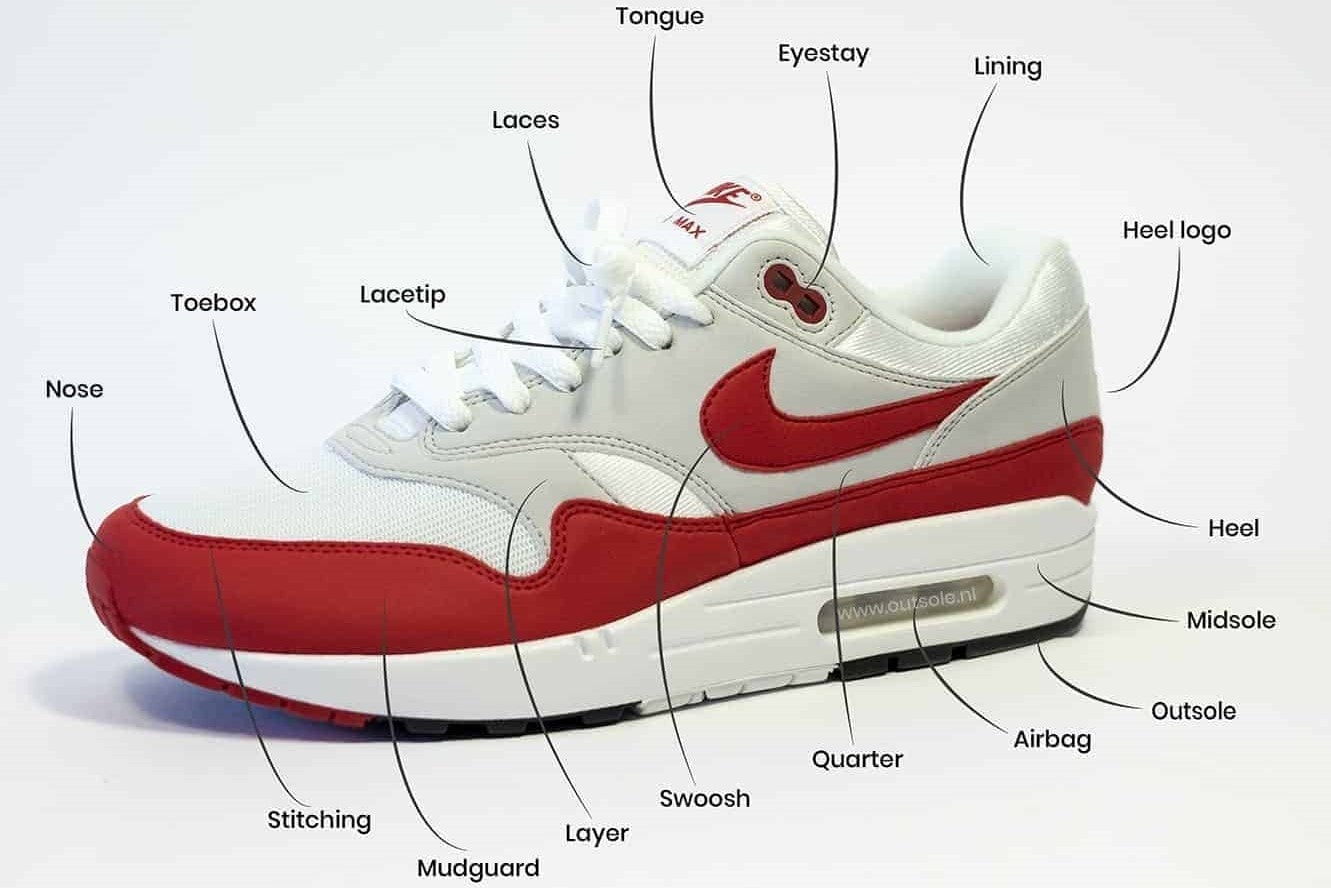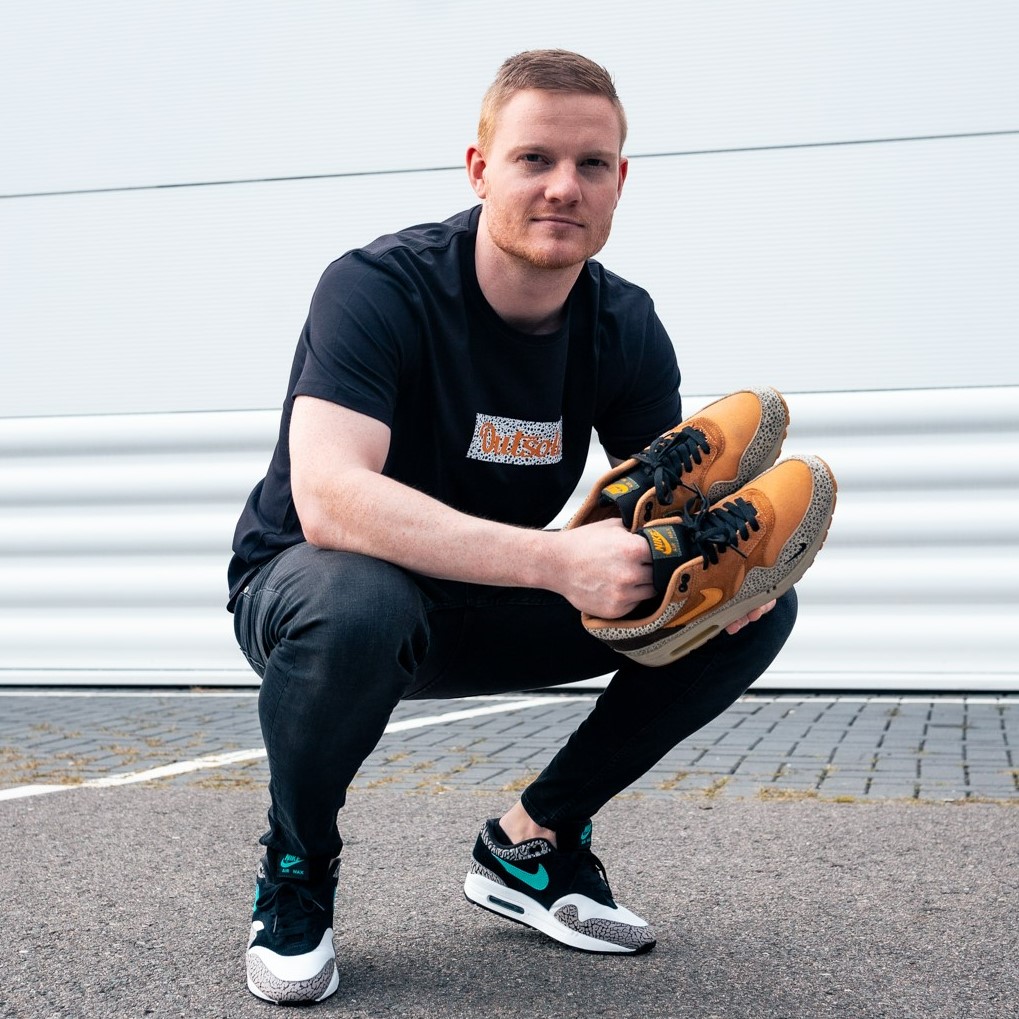Blogs
How to spot a fake, counterfeit or replica Nike Air Max 1 sneaker?
For a sneaker enthusiast, “fake” sneakers are taboo. No go. Really impossible. No matter how dope they are. Fake is fake. Yet almost everyone ever secretly falls for it, and is confronted on the street or at a placed “womft” with the fact that the sneakers might be fake. Shame and a lot of money wasted. Of course you want to prevent that.
Unfortunately the fake sneakers are getting better and better. That’s why we try to help you out as good as possible. So how do you recognize a fake Nike Air Max 1? Read all about it in this blog.
Not just one indicator
First of all: there is not one fixed indicator on which you can base that a sneaker is fake. We hear this too often. It should always be indicated by a stitched size label, it is always visible by how Nike is written on the back heel or one of the sizes in the size label must touch the line at all times. Bullshit. There are exceptions in all cases. And there are many. Nike has released so many different Nike Air Max 1s and they all differ in detail. Both in the shape of sneaker parts, finishing of stitching and seams, and the layout of size labels. With some indicators, such as a wrong size label or wrong material, you have to drop out immediately. With other indicators such as bad stitching, this does not have to be immediately alarming. Not everything is neatly finished in the Nike factory.
We are often asked how we recognize it in a split second. This has to do with the fact that we have been buying and selling sneakers for 15 years. Selling a fake sneaker would be killing for us. Over the years, we have had to learn from each sneaker what we should pay attention to. And believe us, we have also fallen for it sometimes and only noticed anomalies when photographing the pair. Don’t let that be a taboo!
The real AM1 Clot and AM1/97 Sean Wotherspoon are hard to spot. Always do a legit check!
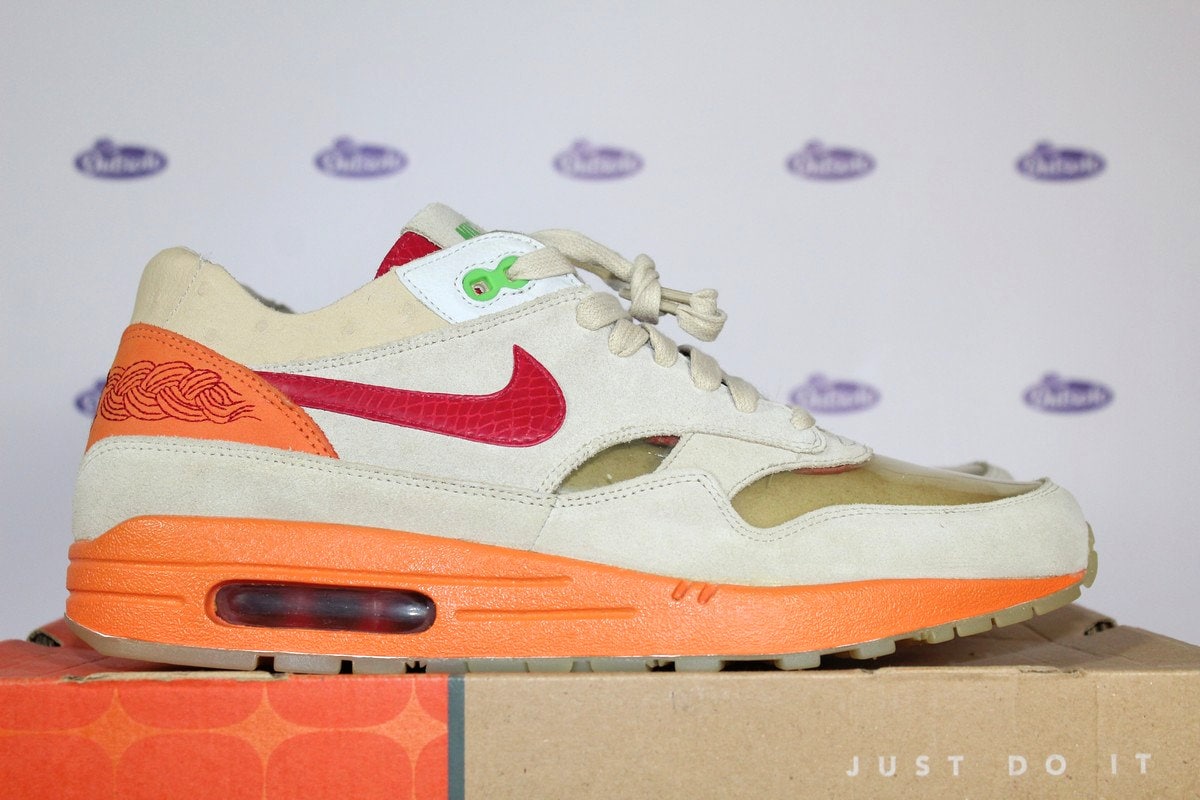
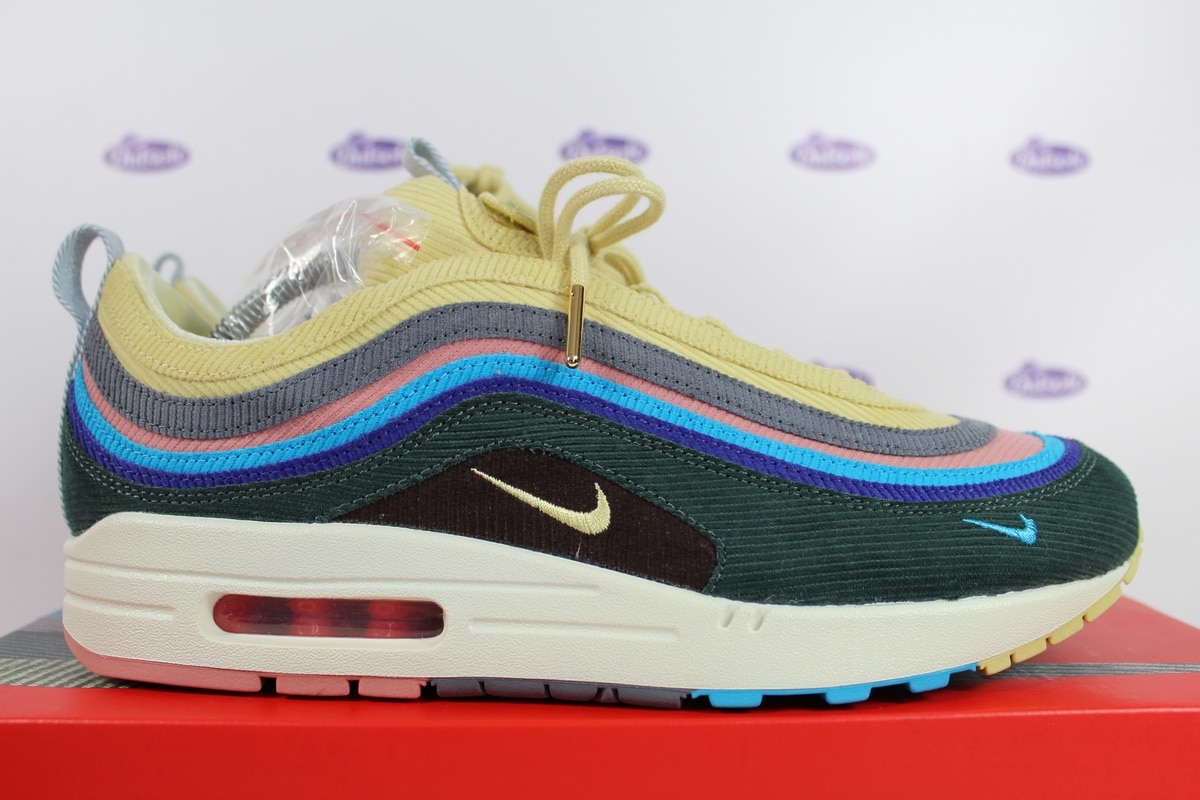
10 indicators on fake Air Max 1s
So there’s no single all-telling indicator. It is a combination of indicators. It differs per pair of Nike Air Max 1 which indicators apply. That makes it difficult. Unfortunately there are very good fakes on the market, so be alert. For example, based on one picture, we can hardly tell the difference between a real and fake Nike Air Max 1 Clot from 2005, or the Nike Air Max 97/1 Sean Wotherspoon. Anyway, with the 10 indicators below for how to spot a fake Nike Air Max 1s you should go a long way.
At the bottom of the blog you will find a picture with all AM1 components designated.
1. Materials and color
Always ask for tagged pictures. A picture with a seller’s name tag, ideally showing the date. Compare the tagged photos with other available pictures of these sneakers to make sure the materials match. Other pictures can be found via Google Images. Are there other materials used or do colors differ? Then pass on the deal immediately. You can easily recognize many fake pairs by the use of wrong colors. Sometimes it’s more cunning and it’s all about details.
At this pictures of this fake Nike Air Max 1 Ben Drury Hold Tight you can see that the mudguard is not made of 3M material. Easy pass!
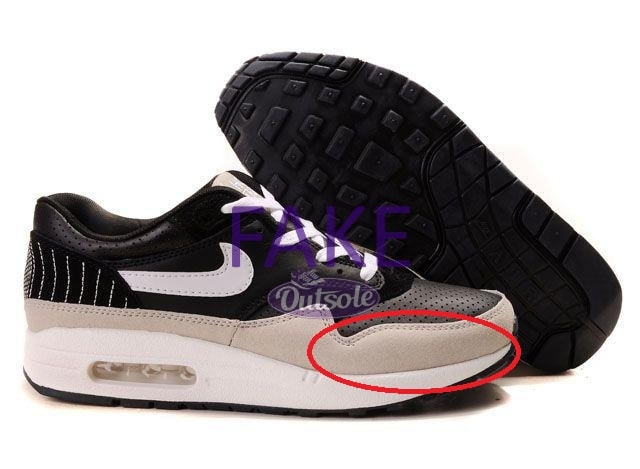
2. Swoosh placement
We see that with fake Nike Air Max 1a the swoosh, the Nike logo, is often placed too low and / or deviates from the original. The swoosh normally extends to the lining of the heel. You can easily google whether this is also the case with this original release. Does the swoosh deviate from your pair? If this is the case, it’s a strong indicator that the pair can be fake. Therefore, check the other indicators extra carefully.
The swoosh of this fake Nike Air Max 1 Adventure Pack starts too low and the curvature doesn’t make sense. Fufu!
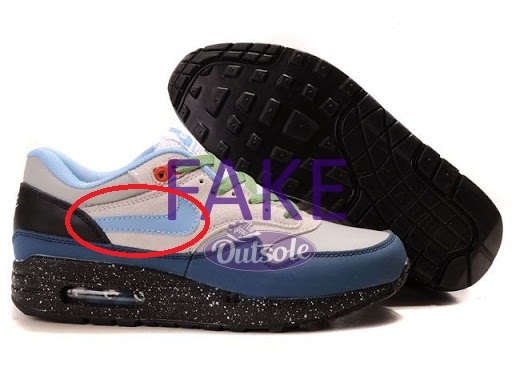
3. Heel shape
The heel of an original AM1 should be curved and the midsole piece should be straight. In addition, the heel is sturdy. The shape of the heel often deviates on fake pairs and this is one of the most important indicators for us. With fake Air Max 1s you often see that you can easily press the heel in, the bulge is missing and the part of the midsole also runs diagonally inward. Is this also the case with your pair? Then check the other indicators extra carefully.
With this fake Nike Air Max 1 Skull Pack we can clearly see that the sole is sloping inwards and the heel follows that shape. Fake!
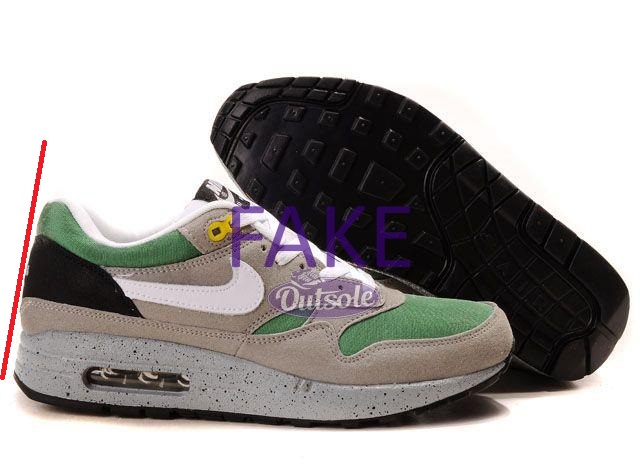
4. Tongue
We often see that a fake Nike Air Max 1 has the tongue shorter than the original pair. The Nike label on the tongue is also often just shorter or not neatly stitched over the top edge of the tongue. Do you see deviations? Check via Google whether this is how it should be or whether the sneakers are simply fake.
There’s not much legit at this Nike Air Max 1 Atmos Elephant Pack, but it is clear that the tongue is waaaay too short!
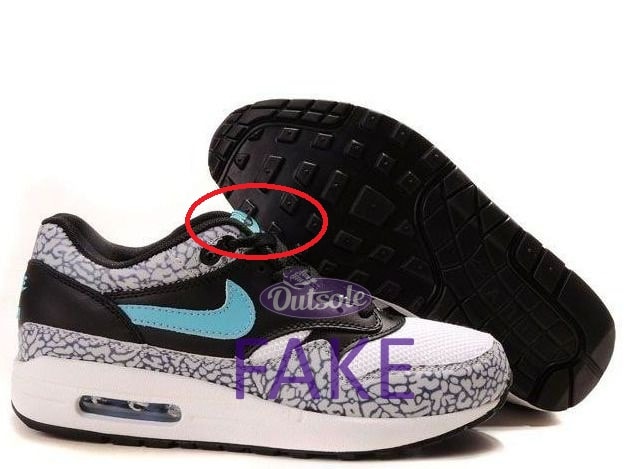
5. Nose
The mudguard and toebox of fake Nike Air Max 1s usually look excellent. We do see that the nose sometimes deviates slightly. In fact, on the near-perfect fake Nike Air Max 1 ACGs, this is pretty much the only clear landmark: there is a dent in the nose. With some fake Air Max 1s we see that the full nose shape is not correct. The toebox is convex and the mudguard around the nose is often too narrow.
With this fake Nike Air Max 1 OG Red we see, among other things, that the mudguard around the nose is too low and the nose is convex. Fake!
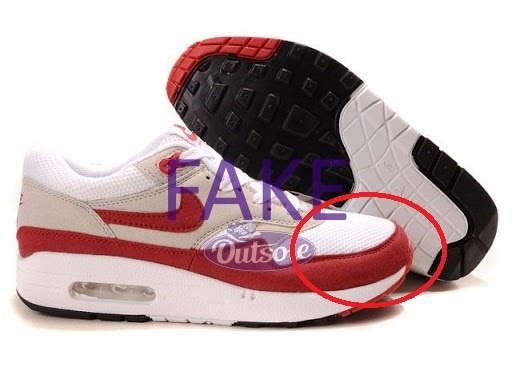
6. Insole and outsole
The insole of a fake sneaker can be different. For example, the print may deviate or the insole is glued. However, this is difficult to validate, but it is important to include in the overall picture. Keep in mind that with a second-hand pair the insole may be exchanged. For the outsole, this can be an important indicator for Nike Air Max 1s with a special or transparent sole. There are often minimal differences.
The lines on the fake Nike Air Max 1 Sketch to Shelf are thinner and blacker than on the original pair. An important indicator to consider when spotting fake Sketch to Shelfs.

7. Size label
The size label is a source of information for sneakers. You will find the product code, production dates and size details here. We see a lot of mistakes here with fake couples. First of all, the product code often differs. Google the product code to find out if it matches. In addition, the production year often deviates. These don’t have to match exactly, but should be in the same date range. You can also easily check this. This also applies to the country of production. We also often see errors in the overall format and the format of the size. One of the four measure notes is usually written against the line above it. Is there space above all four measure notes? Then be alert. Finally, we often see that the size label for fake pairs is a sticker. Not all labels are stitched or pasted in. Compare the size label with a picture from a pair that you know is original.
We see many errors on the size label of this Nike Air Max 1 EM Burgundy, despite the matching product code. The size label is a sticker, the font is incorrect, production date deviates too far, the production country is wrong and nikebetterworld.com is missing.
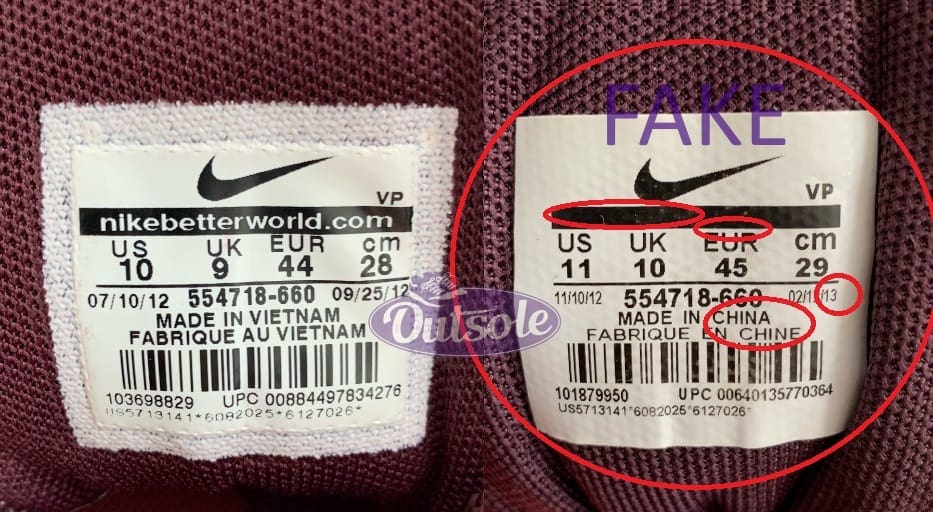
8. Box
The box of a fake pair sneakers often looks different. The color is sometimes not correct, but the print can also differ slightly. We think this is a difficult indicator, as a pair of sneakers may have been released in different boxes. Sometimes in different shapes, sometimes in different colors. It is a good indicator to include in the overall picture though.
When the original Nike Air Max 1 Chili was released, the brown Nike box didn’t exist yet. It should be partially orange. This pictured pair is therefore fake!
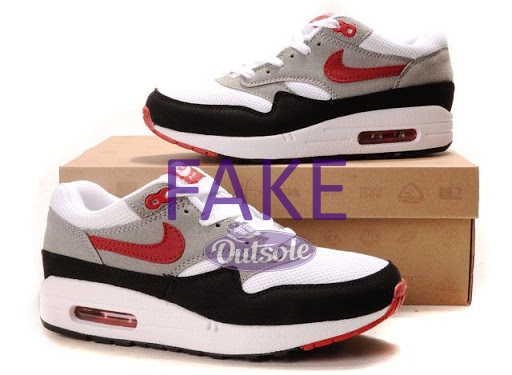
9. Accessories
This is the hardest one to explain, because it is different for every pair of sneakers. Think of extra laces, the little lace bags, folders or extra lacetips. Always compare the accessories with the accessories from an original pair. If something is missing, it doesn’t have to be that exciting. If something deviates in color or shape, this is a good indicator. To get back to the aforementioned Nike Air Max 1 Clot and Nike Air Max 97/1 Sean Wotherspoon, the accessories often differ. For example, the fake Clot is often offered as a “special pack” and the lace bags of the fake Sean Wotherspoon often deviate.
The imaged Nike Air Max 1 Clot Kiss of Death with special accessories is almost always fake. We have not seen an authentic pair sold with this package in the past 10 years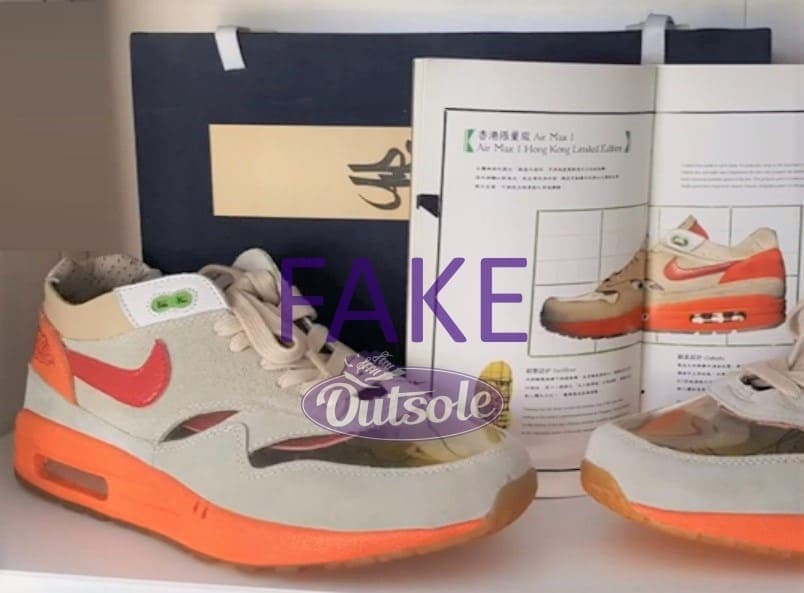
10. Sales Channel
The above indicators are especially important if you buy a pair through private channels. When you buy through a webshop, it is often immediately clear that Nike Air Max 1s are fake. Let’s start with the fact that authentic online shops would NEVER put the Nike Air Max 1 online as a “Nike Air Max 87”. Do you see 87? It’s probably a fake shop. In addition, the retail price of a Nike Air Max 1 is usually between € 140 or € 150. Does the webshop state weird prices as € 63.00 or is everything supposedly discounted by 48%? Then you know enough. After all, almost all webshops with authentic pairs sell the same Nike Air Max 1s. Do you see pairs of sneakers from years ago online; new in box? That is impossible! Use your common sense to determine whether or not it is a legitimate webshop.
On this webshop they supposedly sell an ID, OG Red from 2009 and Skull Pack from 2006. Too good to be true of course. There is no better example of a fake sneaker webshop!

Avoid getting ripped off
Is the seller legit? Are the pictures legit? Do enough research to make sure what you see is what you get. Check if the seller is trustworthy. Request references or double check someone’s identity. Also check whether the photos are actually from the seller. Tagged photos, with date and name card of the seller are a big plus. Is the price “too good to be true”? Then it simply is too good to be true. An Animal for € 150? Fake! A Parra for € 150? Fake! A Sean Wotherspoon for € 200? Fake! When something seems too good to be true, it often is. Don’t fall for it. Do not do it. Your gut is usually right.
If you really want to buy a pair from an unverified seller: USE PAYPAL GOODS & SERVICES! There it is. We cannot make it any clearer.
Tip: you can check if the seller has stolen the pictures in question by dragging these pictures to Google Images. When you find hits with outdated ads or ads from others, you know you’re getting flashed.
Did you know:
- A retro sneaker is sometimes re-released years later with the same product code.
- Some sneakers are produced in successive years. Sometimes the materials even differ in the following year! For example, the Nike Air Max OG Blue 2009 was also released in 2010, but with minimally different materials.
- Both the box and the size label in the sneaker change over the years. Fonts, layout and type. So do not assume standard indicators, but compare with a pair that you know is authentic.
- There are perfectly counterfeit Nike Air Max 1s. For example, the fake Omega Pack and ACG Pack are almost impossible to recognize. So always have a check at a friended AM1 expert, or use the community, for example from Nike Air Max 1 groups.
